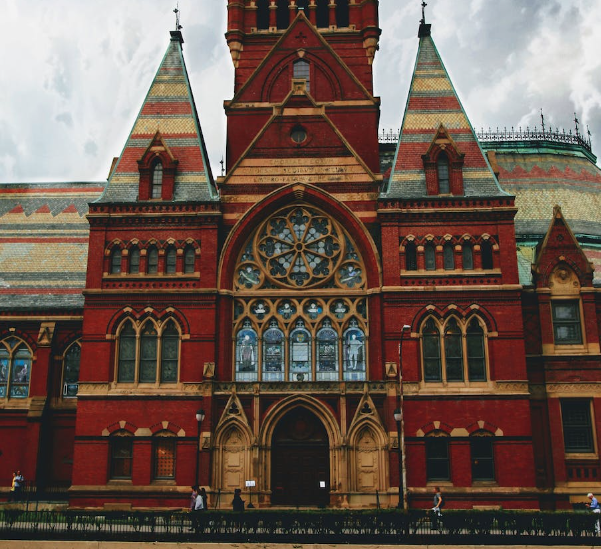United States
Harvard University, The legacy of slavery

A comprehensive report has been published by Harvard University, which provides an account of the institution’s historical connection to the U.S. slave trade. The report highlights instances where members of the faculty and staff were found to have owned slaves, as well as instances where academics were known to have taught concepts related to racial eugenics.
Harvard University, The legacy of slavery
In the year 2019, a committee was established by Lawrence Bacow, the President of Harvard University, with members from several academic units within the institution. The primary objective of this committee was to investigate and reveal the historical connections between Harvard University and the institution of slavery.
During that period, he expressed the belief that the committee’s efforts ought to be firmly based on meticulous study and critical viewpoints. This approach would not only enhance our comprehension of factual information but also enable us to effectively tackle the consequences arising from our findings.
The committee’s investigation revealed that a total of 70 individuals were subjected to enslavement by Harvard faculty and employees over the period spanning from the institution’s establishment in 1636 to the abolition of slavery in Massachusetts in 1783.
A portion of those who were subjected to enslavement resided within the confines of the academic institution and were tasked with the duty of attending to the needs of Harvard University’s presidents, professors, and students. Furthermore, the research revealed that a significant number of the university’s benefactors derived direct financial gains from their involvement in the transatlantic slave trade during the 17th, 18th, and 19th centuries.
The utilization of labor derived from enslaved individuals in both the Caribbean and the American South was prevalent during a certain historical period. The acquisition of wealth by certain individuals was facilitated through the commercial exchange of goods with plantations. Donors within the textile industry procured cotton that was cultivated by individuals subjected to enslavement.
According to the research, a significant proportion of the monetary contributions made or pledged to Harvard University by private persons during the initial half of the 19th century originated from a select group of five individuals who amassed their wealth through involvement in the slave trade and the production of goods reliant on slave labor.
The institution also provided significant support for the investigation of eugenics, a theoretical framework that advocated for the promotion of selective reproduction with the aim of enhancing the genetic quality of the human population.
According to the report, Dudley Allen Sargent, who served as the director of Harvard’s Hemenway Gymnasium from 1879 to 1919, introduced a physical education curriculum that included comprehensive physical examinations, anthropometric measurements, and the documentation of unclothed Harvard and Radcliffe students through photography.
The educational institution has devised a strategy to implement a system of reparations.
Harvard University has delineated a series of future actions it intends to undertake in order to address its historical complicity in the slave trade. These measures encompass the provision of financial reparations to individuals of Black and Indigenous heritage who can trace their lineage back to enslaved individuals inside the United States.According to the report, the detrimental effects resulting from the university’s involvement with slavery and its subsequent consequences extend beyond mere monetary evaluation. However, it is important to note that financial expenditures are an essential prerequisite and fundamental basis for addressing and rectifying the situation.
According to the study, the Legacy of Slavery Fund would be maintained as an endowment that will be wisely invested to facilitate the fulfillment of the recommendations.
The Ivy League institution additionally intends to enhance its collaboration with Historically Black Colleges and Universities (HBCUs) by implementing various programs. These include the appointment of visiting HBCU professors to Harvard for a one-year duration, as well as providing financial support for HBCU students to engage in summer, semester, or yearlong study at Harvard.
The educational institution has expressed its commitment to the identification of Black and Indigenous pupils who can trace their lineage directly to individuals who were subjected to enslavement within the United States.
Everyone has heard of the name Harvard, it is a team synonymous with intellectual excellence and impressive prospects. Few people would want to, if they could, attend а prestigious university where careers are made, breakthroughs are found, and connections are formed. But how much does the average person know about Harvard? It’s time for us to take a deep dive into the heart of the much-lauded university to find out what it is all about, and why it is so universally revered.
Universally recognized as one of the best academic institutions for higher education, Harvard is more than a university, it is also a symbol of educational excellence, pioneering research, and global influence. The University is known for its rich history, its distinguished alumni, and its many amazing contributions across just about any discipline you can think of. So, to get to the heart of what makes Harvard Harvard, we are going to have to do more than journey through its hallowed halls of academia; we are going to have to explore the making of this educational powerhouse in full. So, sit down, get yourself a hot cup of coffee, and prepare for an intellectual adventure!
Harvard: Its Origins and Early History
The story of Harvard begins way back in 1636 in a nascent colonial America. A mere 16 years after the Pilgrims first came ashore at Plymouth, the Massachusetts Bay Colony took a vote to set up a school that would enable them to train ministers. This planted those initial seeds that would eventually be nurtured and grown into the world-renowned institution that we now know as Harvard University. Named after its first benefactor, John Harvard, a young clergyman who left his library and half his estate to the institution, the college was initially modest but held high aspirations.
During the early years of its inception, Harvard played a vital role in shaping the intellectual foundations of the United States. Not only was it a place where higher learning was prioritized, but it was also a cornerstone of the young colony’s social, political, and religious life, so it is fair to say that Harvard has played a highly significant role in shaping America throughout the ages, just as it continues to do so today. Graduates of Harvard at that time would go on, as they so often do today, to be important ministers, teachers, and politicians and their influence cannot be understated.
Of course, the journey to becoming the Harvard we know and love today was not always a smooth one. It often proved difficult for the colonials to find the funding required to keep the college afloat. Not only thаt, but ideological clashes and the uncertainty of living in a new world were also barriers to the smooth sailing of the institution.
However, with every challenge it faced, Harvard was able to navigate a path to success by persisting and adapting at every turn. For example, the college introduced a new curriculum, expanding its scope beyond theology and, over time, became an institution more akin to the European model of a complete university that catered to a wide range of academic disciplines.
These early years, which were so steeped in resilience and adaptability, paved the way for Harvard to grow into the academic behemoth that we know it to be today. The university, from its modest beginnings, lаid a solid foundation upon which a titan of education would be built. It showed that even in the harshest of conditions, learning, and intellectual curiosity could flourish, a testament to the enduring legacy that Harvard continues to uphold to this day.
Building the Harvard Legacy: 18th and 19th Centuries
With the dawn of the 18th century, Harvard truly started to blossom. The university set out to expand and innovate which is what truly set it on course to become the academic titan that we all recognize it to be today. From its humble beginnings as a theological school, Harvard embraced other areas of academia with gusto, embracing the arts, sciences, and humanities in what was to be a lucrative new chapter for the university. Its library, once comprising solely of John Harvard’s collection of 400 books, grew rapidly and exponentially, until it truly reflected the breadth of academia and the country’s burgeoning interest in intellectual exploration of the wider universe.
As a result, Harvard soon became a big draw for intellectual heavyweights such as John Thornton Kirkland, who left a lasting impact on, not only the university but the whole world.
John Thornton Kirkland was the president of Harvard University from 1810 to 1828, and in that time, he went to bt for a number of causes, most notably, educational reform within the institution. He was the main voice calling for a broadening of the curriculum to include things such as modern languages, political economy, and history, during that time. It is fair to say that his tenure was a fruitful one, breaking new ground in professional education at every term.
Another important figure in Harvard’s history was Charles W. Eliot, who became president of the college in 1869 and went on to spearhead a significantly transformative era in the history of the place.
Eliot was a tireless advocate for the modernization of education, introducing some of the first elective courses in America. This was a truly iconic and important move that allowed students to tailor their education to the things that interested them the most. His tenure also
Undertook the establishment of the Graduate School of Arts and Sciences, which was a key factor in pushing Harvard into the forefront of graduate education.
Not only that, but it was Eliot who can be rightly credited for Harvard’s evolution from theological college to comprehensive university. He made the changes that transformed Harvard from a place where knowledge was imparted to a vital hub for the generation and exploration of knowledge itself. He believed that, through research, students could participate in active learning, which would allow them to be net contributors to the intellectual progress of society.
That is why it is fair to say that the 18th and 19th centuries were so pivotal in shaping Harvard’s identity. The institution truly flexed its academic muscles, broadened its intellectual reach, and morphed from a colonial college into a modern university like the one we are so fond of today. The era witnessed the planting of seeds that would blossom into Harvard’s diverse, comprehensive, and world-class range of academic offerings, and for that, we should all be truly thankful.
Harvard in the 20th Century: Pushing Boundaries
In the 20th century, Harvard continued to take the lead as one of the country’s best educational institutions. During this period, the university was never not transforming, innovating, and pushing boundaries in what it meant to be a place of higher education. This period was marked by a very dramatic increase in student diversity, groundbreaking research developments, and a significant expansion of Harvard’s endowment.
At the dawn of the 20th century, Harvard was a place that primarily welcomed white men through its doors, but those doors were to soon widen, welcoming a more diverse student body into its hallowed halls of intellect. During this period, women gained a firm foothold with the establishment of Radcliffe College, an all-woman’s institution that would eventually merge with Harvard. Then international students were gradually included into the fold, along with students from various minorities, making Harvard a much more diverse, interesting, and intellectually stimulating place than it had ever been before.
When it comes to research, the 20th century was important for the college. Harvard was very much at the forefront of several stunning development, including the building of a manned flight simulator, which was the first one ever made, to the cutting-edge work its researchers did on cognitive sciences, and not forgetting, what could be the most amazing and astounding of all, the revelation that was the structure of DNA, which Harvard researchers, were of course, instrumental in discovering for the world, forever pushing the boundaries of human knowledge and changing the worlds of science and medicine forever.
Meanwhile, Harvard’s endowment, a financial resource allowing the university to maintain its commitment to knowledge, research, and innovation, experienced significant growth during this period, it swelled from around $22 million at the beginning of the century to a mind-blowing $40.9 billion by its close, bolstering the university’s capacity to offer financial aid to smart students who needed a helping hand, attract world-class faculty members, and invest in cutting-edge research.
Harvard Today: A World Leader in Education
Skip ahead to current time and we can observe that Harvard has developed into a flourishing champion of academic excellence. With no less than thirteen graduate and professional schools, Harvard is at the top of the tree when it comes to providing a rich tapestry of academic programs that not only teach students the skills and information they need to excel at high levels of professional life, but that also enrich them personally and enable them to follow their passions wherever they may take them. From law and medicine to business and public health, the academic landscape at Harvard is as vast as it is deep, fostering an environment of intellectual growth and innovation.
Harvard’s idyllic campus, with its iconic red-brick buildings and sprawling green spaces, is more than just a collection of lecture halls and libraries. It’s a vibrant, buzzing microcosm where intellectually curious people can come to study, enjoy extracurriculars, and network with future movers and shakers who will enable them to get on in life.
Today, it is fair to say that Harvard remains committed to groundbreaking research and innovation. From tackling climate change to advancing healthcare, Harvard is at the cutting edge, addressing some of the world’s most pressing challenges as and when they pop up The spirit of discovery that permeates its hallowed halls is a testament to its enduring commitment to knowledge and advancement in every walk of life.
Harvard’s Impact and Future Outlook
The impact of Harvard on global education is, it is fair to say, nothing short of profound and far-reaching. It has shaped minds, crafted leaders, and been a key player in revealing new and important knowledge to us all. As we look forward, there is no doubt in our minds that Harvard will continue to educate us, innovate the world around us and change society for the better, just as it has in the past.
As you can now see, Harvard really does have the longest and interesting history in educational terms, which stretches back even further than many people realize or even conceptualize in their minds. It may have started out as a humble place to learn more about god and how to minister to the locals, but today, it is known for its intellectual supremacy in areas as diverse as biology and economics. Harvard is more than just an institution; it’s a testament to the enduring power and infinite potential of education.














You must be logged in to post a comment Login